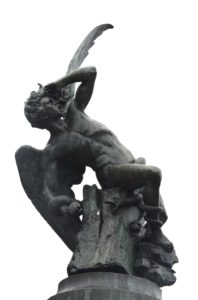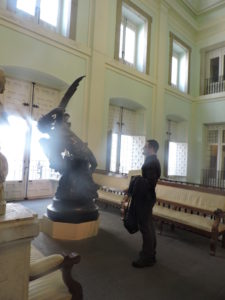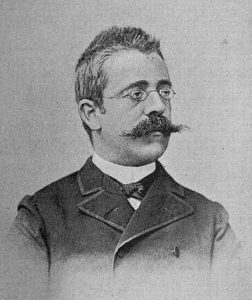
Spanish sculptor Ricardo Bellver rendered the Miltonic-Romantic Lucifer to perfection with El Ángel Caído (The Fallen Angel, 1877). The statue imagines Milton’s ruined archangel as a classical heroic nude reeling back off of a chunk of rocky cliff his serpent-coiled lower half rests atop, the angelic-winged Lucifer’s long, streaming locks of hair windswept upside his youthfully fair face, which is racked with fierce pain but exudes defiant pride as he releases an earthshattering scream toward the Heaven he has been banished from. I have always felt that Bellver’s masterpiece is the very apex of the Satanic sublime, and having at long last seen El Ángel Caído in person has certainly reinforced my position.
A native of Madrid, Ricardo Bellver was a student of the Spanish capital’s Royal Academy of Fine Arts of San Fernando, and in 1874 he earned a pension to complete his studies in Rome, where he sculpted El Ángel Caído in 1877. Bellver’s statue, commissioned by the Duke of Fernán Núñez, was inspired by Milton’s Satan in Paradise Lost (1667), as described in the following two passages from the poem’s infernal introduction of the fallen archangel:
Had cast him out from Heav’n, with all his Host
Of Rebel Angels… (I.36–38)
…round he throws his baleful eyes
That witness’d huge affliction and dismay
Mixt with obdúrate pride and steadfast hate… (I.56–58)
Milton’s Satan is already damned to Hell in these lines taken as inspiration for El Ángel Caído, and Bellver accordingly brought to life not a falling but a fallen angel. Yet Bellver portrayed Milton’s Satan as Lucifer, which is to say, the fallen angel, though already Hell-doomed in the dramatic moment the statue captures, retains his preeminent angelic beauty, including his massive feathery wings—both of which were major hallmarks of Romantic renditions of Milton’s Satan in the visual arts.
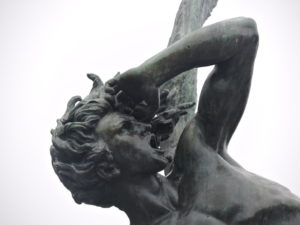 A likely inspiration for El Ángel Caído was Laocoön and His Sons, displayed in the Vatican—not least because of the serpents coiled around the fallen angel’s limbs—but Lucifer’s dramatic position also bears a striking resemblance to Gustave Doré’s 1866 engraving of Milton’s despairing Satan atop Mt. Niphates. But Bellver’s Fallen Angel strikes the viewer as far more heroic than these two iconic images. The look of Lucifer’s thunder-stricken countenance unleashing that desperate cry heavenward is best described as “mixed defiance and despair,” to borrow a line from Lord Byron (The Giaour [1813], l.908), the exiled angelic prince’s form best described as “Majestic though in ruin,” to borrow one from Milton (Paradise Lost, II.305).
A likely inspiration for El Ángel Caído was Laocoön and His Sons, displayed in the Vatican—not least because of the serpents coiled around the fallen angel’s limbs—but Lucifer’s dramatic position also bears a striking resemblance to Gustave Doré’s 1866 engraving of Milton’s despairing Satan atop Mt. Niphates. But Bellver’s Fallen Angel strikes the viewer as far more heroic than these two iconic images. The look of Lucifer’s thunder-stricken countenance unleashing that desperate cry heavenward is best described as “mixed defiance and despair,” to borrow a line from Lord Byron (The Giaour [1813], l.908), the exiled angelic prince’s form best described as “Majestic though in ruin,” to borrow one from Milton (Paradise Lost, II.305).
Romantic iconography inspired by Paradise Lost visualized Milton’s Satan very much in the spirit of Romantic radical William Hazlitt’s paean to the arch-rebel: “His ambition was the greatest, and his punishment was the greatest; but not so his despair, for his fortitude was as great as his sufferings.…[T]he fierceness of tormenting flames is qualified and made innoxious by the greater fierceness of his pride…”1 El Ángel Caído is quintessentially Romantic, yet uniquely so, for while Milton’s Satan was portrayed as singularly splendid amidst his loss by many Romantic artists, they tended to choose his most heroic moments—rising from the burning lake, summoning his legions, or facing off with Death himself—whereas Bellver chose Lucifer’s fall from Heaven/his realization of his ruin in Hell, but still capturing the dazzling splendor of Satan as Romantic hero.
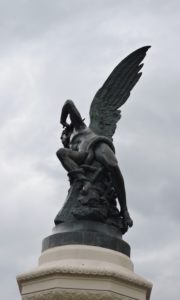 El Ángel Caído crystallizes the Miltonic Lucifer’s defining moment of cataclysmic loss, but Bellver’s sublime statue evokes not mere fear but awe, compelling viewers to admire the glorious, godlike fallen angel for withstanding the omnipotent ire of “The Thunderer” (Paradise Lost, VI.491). Bellver’s is no horned half-beast Devil beneath the heel of a stoically triumphant St. Michael. Of course, the fallen angel is bound by hostile serpents, which stand in for Milton’s “Adamantine Chains” (I.48), as well as serve as a symbolic reminder that the Heaven-defying “Apostate Angel” (I.125) becomes “Th’ infernal Serpent” (I.34), who is “to [him]self enthrall’d” (VI.181). (“…Pride and worse Ambition threw me down,” Milton’s Satan cries, yet rejecting even the thought of atonement because repentance requires “submission; and that word / Disdain forbids me…” [IV.40, 81–82]). Nevertheless, Bellver’s Fallen Angel focuses attention on Lucifer in Romantic fashion, the defeated rebel angel’s catastrophe paradoxically portrayed in a flattering light, his heroic resolution shining forth despite his despair.
El Ángel Caído crystallizes the Miltonic Lucifer’s defining moment of cataclysmic loss, but Bellver’s sublime statue evokes not mere fear but awe, compelling viewers to admire the glorious, godlike fallen angel for withstanding the omnipotent ire of “The Thunderer” (Paradise Lost, VI.491). Bellver’s is no horned half-beast Devil beneath the heel of a stoically triumphant St. Michael. Of course, the fallen angel is bound by hostile serpents, which stand in for Milton’s “Adamantine Chains” (I.48), as well as serve as a symbolic reminder that the Heaven-defying “Apostate Angel” (I.125) becomes “Th’ infernal Serpent” (I.34), who is “to [him]self enthrall’d” (VI.181). (“…Pride and worse Ambition threw me down,” Milton’s Satan cries, yet rejecting even the thought of atonement because repentance requires “submission; and that word / Disdain forbids me…” [IV.40, 81–82]). Nevertheless, Bellver’s Fallen Angel focuses attention on Lucifer in Romantic fashion, the defeated rebel angel’s catastrophe paradoxically portrayed in a flattering light, his heroic resolution shining forth despite his despair.
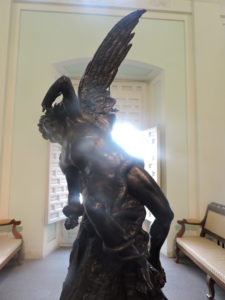 Bellver’s depiction of the Miltonic Lucifer in all his damned, defiant magnificence won the artist First Medal in Spain’s National Exhibition of Fine Arts, held in Madrid in 1878. In the same year, El Ángel Caído was cast in bronze for the third Paris World’s Fair (where, incidentally, the head of Lady Liberty was also on display). Bellver’s Fallen Angel enjoyed a brief stay in Madrid’s Prado Museum, and in 1879 Benito Soriano Murillo, director of the Prado, decided to hand the statue over to the City of Madrid, believing El Ángel Caído should be placed outdoors to fully capture The Fallen Angel’s dramatic effect. In 1885, The Fallen Angel was finally stationed in Madrid’s majestic Retiro Park, resting atop a grand pedestal erected by the renowned architect Francisco Jareño, which includes at its base various demonic faces spouting water into the fountain below, each demon clutching assorted reptiles and fish in their talons. (The bestial demonic busts aren’t the only Satanic cliché El Ángel Caído was subject to; the statue apparently stands 666 meters above sea level as well.) The Prado tried to reclaim El Ángel Caído in 1998, but the statue remains exalted in Retiro Park for all to see. Fortunately, however, a replica Fallen Angel, which can be admired up close, resides within Madrid’s Royal Academy of Fine Arts of San Fernando, Bellver’s alma mater.
Bellver’s depiction of the Miltonic Lucifer in all his damned, defiant magnificence won the artist First Medal in Spain’s National Exhibition of Fine Arts, held in Madrid in 1878. In the same year, El Ángel Caído was cast in bronze for the third Paris World’s Fair (where, incidentally, the head of Lady Liberty was also on display). Bellver’s Fallen Angel enjoyed a brief stay in Madrid’s Prado Museum, and in 1879 Benito Soriano Murillo, director of the Prado, decided to hand the statue over to the City of Madrid, believing El Ángel Caído should be placed outdoors to fully capture The Fallen Angel’s dramatic effect. In 1885, The Fallen Angel was finally stationed in Madrid’s majestic Retiro Park, resting atop a grand pedestal erected by the renowned architect Francisco Jareño, which includes at its base various demonic faces spouting water into the fountain below, each demon clutching assorted reptiles and fish in their talons. (The bestial demonic busts aren’t the only Satanic cliché El Ángel Caído was subject to; the statue apparently stands 666 meters above sea level as well.) The Prado tried to reclaim El Ángel Caído in 1998, but the statue remains exalted in Retiro Park for all to see. Fortunately, however, a replica Fallen Angel, which can be admired up close, resides within Madrid’s Royal Academy of Fine Arts of San Fernando, Bellver’s alma mater.
For me—as someone hell-bent on preserving the Miltonic-Romantic legacy of Lucifer—venturing to see El Ángel Caído was like a pilgrimage, for Ricardo Bellver’s statue truly brought this proud tradition’s Lucifer to life. Walking through Madrid’s Retiro Park is a wonderfully daunting experience to begin with, but to see The Fallen Angel in person was simply sublime. The countless photos of El Ángel Caído I had seen over the years simply could not compare to the overwhelming feeling of standing in the Plaza del Ángel Caído, staring up at this artistic masterpiece.
As amazing as the pedestaled Fallen Angel in Retiro Park was, I am tempted to say that visiting the replica in the Royal Academy of Fine Arts of San Fernando had more of an impact on me. There, El Ángel Caído rests at the top of the entryway staircase, and walking up to the statue, which was illuminated by the almost heavenly brilliance of the room’s natural light, was genuinely awe-inspiring. I was able to truly appreciate the massiveness of Lucifer’s figure; if the fallen angel were to come to his feet, he would probably tower over me at about eight or nine feet tall. There was not much traffic in the open room, and amid the remarkable quiet, which made my footfalls echo as if I were in a capacious cathedral, I was able to spend much time admiring every detail of Bellver’s exquisite work. This profoundly moving experience, in all honesty, induced the feeling of somehow coming face-to-face with Lucifer—as imagined by the Miltonic-Romantic tradition—frozen in his fall.
I highly recommend venturing to see both statues of El Ángel Caído in Madrid. While it was a deeply personal experience for me, I would be remiss if I did not share the videos and photos I managed to capture in Retiro Park and the Royal Academy of Fine Arts of San Fernando of Ricardo Bellver’s Fallen Angel—the visual culmination of the grand Miltonic-Romantic-Satanic tradition I am so very proud to preserve.
— Christopher J. C.
Notes
1. William Hazlitt, Lectures on the English Poets (1818), “Lecture III: On Shakespeare and Milton,” in The Romantics on Milton: Formal Essays and Critical Asides, ed. Joseph Anthony Wittreich, Jr. (Cleveland: The Press of Case Western Reserve University, 1970), p. 384.↩
